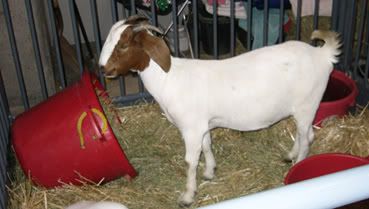Difference between revisions of "Rohgen goat"
Mikitivity (Talk | contribs) m (→Appearance) |
Mikitivity (Talk | contribs) m (→Appearance) |
||
| Line 4: | Line 4: | ||
{{image|http://i26.photobucket.com/albums/c111/mcalamari/NationStates/GOAT1.jpg|left|Rohgen goat|Rohgens are bred throughout Mikitivity.}} | {{image|http://i26.photobucket.com/albums/c111/mcalamari/NationStates/GOAT1.jpg|left|Rohgen goat|Rohgens are bred throughout Mikitivity.}} | ||
| − | Rohgens are medium sized goats that are mostly white or grey with brown heads. Sometimes the goats will be all brown, due to a recessive gene, but other than the color variation, the goats are identical to other Rohgens. Like most goats, when healthy, their short tails curl upwards. | + | Rohgens are medium sized goats that are mostly white or grey with brown heads. Their coloring makes them harder to spot on mountain sides at night. Sometimes the goats will be all brown, due to a recessive gene, but other than the color variation, the goats are identical to other Rohgens. Like most goats, when healthy, their short tails curl upwards. |
In some countries their horns are not removed, as the goats are herded on the sides of hills and mountain slopes, where they may need their horns to fend off predators. Though generally not aggressive, mothers will tend to head butt other adults that approach their young and their horns may wound other adults. | In some countries their horns are not removed, as the goats are herded on the sides of hills and mountain slopes, where they may need their horns to fend off predators. Though generally not aggressive, mothers will tend to head butt other adults that approach their young and their horns may wound other adults. | ||
Revision as of 01:39, 14 December 2006
The Rohgen is a breed of goat, named after the region in Mikitivity where the breed originated, the Rohgen valley in Brey and Thoris cantons. Rohgens are medium sized, moderate in production, and have a relatively low butterfat content in their milk. Today they are found throughout most of Mikitivity where they are farmed for their milk or used to aid in weed maintence.
Contents
Appearance
</div>Rohgens are medium sized goats that are mostly white or grey with brown heads. Their coloring makes them harder to spot on mountain sides at night. Sometimes the goats will be all brown, due to a recessive gene, but other than the color variation, the goats are identical to other Rohgens. Like most goats, when healthy, their short tails curl upwards.
In some countries their horns are not removed, as the goats are herded on the sides of hills and mountain slopes, where they may need their horns to fend off predators. Though generally not aggressive, mothers will tend to head butt other adults that approach their young and their horns may wound other adults.
Does typically weigh around 150 lb (68 kg) and bucks weigh over 200 lbs (91 kg). Young reach adult sizes when they are about 1 year old, but their horns develop their second year.
Habitat
Rohgens predate human settlement in the Thuvian and Solace mountains in Mikitivity, and prefer colder, rocky terrains.
Native Environment
List of countries where Rohgens are a native species:
Non-Native Environment
Due to their calm nature, Rohgens are sometimes bred outside of their native habitat.
List of Countries where Rohgens are an introduced species:
- unknown
Diet and Predators
One of the greater dangers to Rohgens is exposure to the elements and risk of parasitic infection. Like many other goats, Rohgens are highly suspectible to diseases such as foot rot or black leg. The goats can catch these diesases through prolonged contact with containated soils. Penicillin and other anti-botics are extremely effective in fighting the infections and Rohgens whom are treated make immediate recoveries. Younger goats have strong immunities to these sorts of dieases.
Life Cycle
Rohgen goats have a seasonal breeding cycle that beings in the fall when the days begin to grow shorter. Bucks typically go into rut, a period when the male's appetite decreases and his sexual desire increases, a few weeks after the does begin to go into heat. Bucks that are in rut will be aggressive towards only other bucks in rut when a doe is near. When the buck finds a doe ready to reproduce, he'll mark her by urinating on her, thus negating her own sent and preventing other bucks from taking an interest in her. Competing bucks will head butt each other until either one tires or the doe leaves.
As with most goats, the gestitation period is approximately 150 days. Typically twins or triplets are born in a process known as kidding. The birth of more than 2 or 3 kids is extremely rare, with only the two stronger kids surviving the spring. Rohgen kids typically nurse for 6-7 months, which is a longer period than most goats.
Rohgens tend to live 9 to 12 years, having a slightly shorter lifespan than many other goat species, but there is a higher precentage of the goats that live out their full 12 year lifespan.

